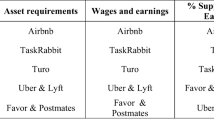Abstract
Empirical evidence has shown that people systematically overrate own performance relatively to others. This paper investigates production with identical workers where each one believes to be more productive than other workers. In a simple efficiency wage model, we ask how these seemingly incompatible beliefs can be made compatible with one another. We suggest that to compensate for the subjectively perceived productivity gap, each worker chooses an effort level lower than that attributed to others. The latter is estimated as the lowest effort that allows to pass the firm's monitoring test. Since rational agents will not maintain expectations which turn out to be systematically wrong, we introduce a "consistency requirement for false beliefs". Accordingly, predictions based on the "wrong" model must agree with the observations of the "true" model. We show that even with consistency, less effort is supplied than in the full information setting. Hence, the wage-effort relationship gets less efficient from the firm's viewpoint. At a first sight, at the firm-level workers gain from holding false beliefs, while profits unambigously fall. At the aggregate market outcome, however, the firms' labor demand declines, total output falls, and the rate of unemployment rises, decreasing workers utility again.
Similar content being viewed by others
References
Adams, J. Stacy (1963). Toward an understanding of inequity, Journal of Abnormal and Social Psychology 67: 422–36.
Akerlof, George A. and Yellen, Janet L. (1990). The fair-wage-effort hypothesis and unemployment, Quarterly Journal of Economics 40: 255–72.
Hamermesh, Daniel S. (1975). Interdependence in the labor market, Economica 42: 420–39.
Meyer, Herbert (1975). The pay for performance dilemma, Organizational Dynamics 3: 39–50.
Muth, F. John (1961). Rational expectations and the theory of price movements, Econometrica 29: 3–22.
Rees, Akbert (1993). The role of fairness in wage determination, Journal of Labor Economics 11: 243–52.
Shapiro, C. and Stiglitz, J. E. (1984). Equilibrium unemployment as a worker discipline device, American Economic Review 74: 433–44.
Smith (1987).
Sparks, R. (1986). A model of involuntary unemployment and wage rigidity: worker incentives and threat of dismissal, Journal of Labor Economics 4: 560–81.
Author information
Authors and Affiliations
Rights and permissions
About this article
Cite this article
Pichler, E. How to beat the average. Quality & Quantity 31, 217–231 (1997). https://doi.org/10.1023/A:1004201429900
Issue Date:
DOI: https://doi.org/10.1023/A:1004201429900




